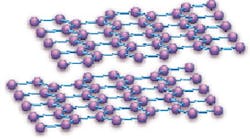Many researchers are eying graphene for its potential use in electronics applications. Because single-layer graphene (SLG) is gapless, however, they keep finding that it cannot be completely turned off. Regardless of the number of electrons on SLG, it always remains both metallic and a conductor. Yet a research team led by physicists at the University of California, Riverside has now found that the intrinsic energy gap in bilayer graphene (BLG) grows with an increasing magnetic field.
Generally, the size of a material's energy gap determines whether it is a conductor (no gap), semiconductor (small gap), or insulator (large gap). When the number of electrons on the BLG sheet is close to 0, the researchers have found that the material becomes insulating. This finding suggests that graphene could eventually be used as a semiconductor substrate, as engineers working on digital applications need to turn their devices on (for a conductor) and off (for an insulator).
Because of graphene's planar and chicken-wire-like structure, sheets of it lend themselves well to stacking. BLG is formed when two graphene sheets are stacked in a special manner (see figure). Like graphene, BLG has high electron conductivity. This high current-carrying capacity results from the extremely high velocities that electrons can acquire in a graphene sheet.
According to Chun Ning (Jeanie) Lau, an Associate Professor of Physics and Astronomy, BLG becomes insulating because its electrons spontaneously organize themselves when their number is small. A typical conductor has a huge number of electrons, Lau explains, which move around randomlyrather like a party with 10,000 guests with no assigned seats at dining tables. If the party only has four guests, however, the guests will have to interact with each other and sit down at a table. Similarly, when BLG has only a few electrons, the interactions cause the electrons to behave in an orderly manner.
In their research, which is detailed in the January 22 online edition of Nature Nanotechnology, the team also has measured the mass of a new type of massive quantum particle that can be found only inside BLG crystals. They were motivated by theoretical work, which anticipated that new particles would emerge from the electron sea of a BLG crystal. Despite the excitement over this initial research, the team notes that the energy bandgap of the graphene materials they have investigated so far is still too small for practical applications. Yet it does suggest a promising path in trilayer or even tetralayer graphene, which would most likely have larger energy gaps.

